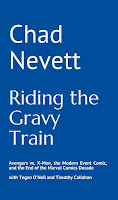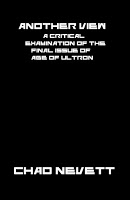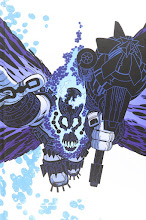gThis is our first "group project" and it's each of us picking who we think are the most influential writers in mainstream comics from the period of 1990(ish) to the present. We each were able to choose up to five writers. We're focussing on the mainstream because that's where trends and patterns are more easy to see. If you look outside of the mainstream, there are trends and patterns, but not nearly as many, or as easy to see. Also, for each person, they are listed alphabetically, as we want to avoid the whole "top five" aspect and just pick writers who we think have had a large influence.
Erin Clark
Chris Claremont
Yeah, yeah, I know. He's unreadable now, but he used to be good. Hell, his run on the Uncanny X-Men, with its emphasis on characters, their relationships, and an abundance of on-going plot arcs, went a long way in changing the sort of story that was written in American comics. Good or bad, a lot of the stuff on the superhero shelves wouldn't be there without Claremont.
Neil Gaiman
His Sandman was intelligent, low-key, and adult without being needlessly 'dark', 'gritty' or pornographic. He writes books that appeal to *everyone*, not just the die-hard comic fans.
Alan Moore
The master. The greatest comics writer, well, *ever*. There's really not much else to say.
Grant Morrison
His books have a sense of fun, and the great, mad ideas more often seen in European comics. A great antidote to the rampant cynicism of the 80s. He attempts to merge clever stuff with the giant blockbuster, sometimes not always successfully.
Steve Higgins
Daniel Clowes
If you ask most indie creators which artists they follow, who inspires them the most, Daniel Clowes will top the list for most of them. Since the end of the '80s, Clowes has been giving the world a window into his madness with a comic known as Eightball. Clowes has used this comic to experiment as its stories have ranged from surreal to mundane, from dark comedy to human drama, from short stories to serials to long-form comics. In Eightball Clowes has done it all, and it has all been both innovative and brilliant.
Neil Gaiman
Neil Gaiman created Sandman. Sandman helped comics to gain acceptance amongst mainstream readers, and it broke comics into the bookstores for the first time. Sandman got writers thinking about writing their comics in a new way, writing with a bigger picture in mind. At its very worst, that meant that creators began to write their stories for the trade paperback collection, but at its best it inspired other creators to take their time to develop characters, to tell epic stories that were larger than life, to mix genres such as horror, fantasy, superhero and more into something completely new. Every writer working in the era since Sandman's debut has had to live in the legacy of that marvelous comic, and it is a legacy that can only inspire other writers to greatness.
Otomo Katsuhiro
It is relatively simple to see why Otomo Katsuhiro is one of the most influential creators of the modern era, especially to the Western world. In the late '80s, he adapted his long-running manga series Akira into an animated feature, and when it hit US shores in 1988, it created a sensation. Sure, people had heard of manga before Akira, but Akira is what made manga cool. Without Akira, manga would not have gained the foothold it has on our comics industry today, and thus with that one project, Otomo Katsuhiro changed the face of comics publishing forever.
Frank Miller
Some would argue that by the modern era Miller's most influential works were behind him. His work on Batman and Daredevil redefined comics in the 1980s, but what has he done since then that is worthy of note? The answer boils down to two words: Sin City. Artistically Sin City is a masterpiece which redefined the ideas people had about what was possible with black and white comics, and Miller is most often given praise for his art on the book first and foremost. But to ignore the writing of Sin City is to do him a disservice, for in it he takes the fractured heroes of his earlier mainstream work and gives them a twist. His characters are a bit darker than what we’re used to seeing in comics, for they live in an even darker world. His characters are on display so that the purest of heroes and meanest of bastards seem to all live not in a black and white world but in between, in the gray areas of morality.
Alan Moore
A list of influential comic creators cannot be complete without Alan Moore. Like Miller, he is most known for his earlier works in which he deconstructed the genre of superheroes, including the seminal Watchmen; however, his works in recent times have been about reconstruction. Supreme, Top 10, 1963, Tom Strong—these works rebuilt superhero comics from the ground up, distilling those elements that really made these stories shine and shoving them to the forefront again. If you liked the wild ideas of Morrison's JLA or the widescreen action of Ellis's Authority, you owe Moore a debt of gratitude.
Won Kim
Brian Azzarello
For his work on 100 Bullets, taking cinematic neo-noir (as seen in films like John Dahl's The Last Seduction and Red Rock West, McQuarrie's Way of the Gun), mixing some conspiracy theory into the broth, and "pushing it" into Hip Hop turf.
To the best of my knowledge, few (outside indies, like David Lapham's work on Stray Bullets, or Europeans, like Jodoworsky and Bess in the recently translated Son of the Gun trade collections) mines the same turf. Assuming Hip Hop remains a viable cultural movement, I predict we will see more of this kind of hip hop noir popping up in urban-set mainstream titles, likely those featuring urban vigilantes, like Batgirl, Manhunter, Luke Cage, Daredevil, etc.
Ed Brubaker & Greg Rucka and Brian Michael Bendis
I very much like the work Greg Rucka, Ed Brubaker and BM Bendis have done in titles like Gotham Central, Catwoman (a great, great revival) and Daredevil, but I cannot help but think that their crime noir work is still overshadowed to a large degree by Denny O'Neil, Max Allen Collin's and Frank Miller's take on the Batman from the 70's- and 80's, which opened the doors for their grittier take on vigilante genre.
It's largely forgotten these days, but Brubaker wrote a truncated (originally planned for 25 issues, cut down to 16 due to low sales) sci fi book that featured Quadrophrenia inspired punk teenagers struggling to survive in very Blade Runner-esque dystopian urban future, on the verge of environmental collapase, titled Dead Enders. I see echos of this frank approach to youthful amorality in titles like the sadly cut short The Monolith, NYX and survivors like X-23 and even Runaways. (Credit is also due here however to a great 80's phenomenon of the B&W revolution: Los Bros Hernandez' Love and Rockets and the revival of punk-mod by the creators of Tank Girl) These titles attest to a welcome trend to a minutely more realistic look at teenagers in titles like The Teen Titans and the new "twenty-something" Outsiders.
Chris Claremont
Criminally under-rated today (likely because of the writers seeming descent into a mind of mental menopause) is the great Chris Claremont. In truth, I find his X-books almost impossible to read today, his purple prose and dialogue defining the furthest extreme limit one can take Stan Lee's hyperbole and alliteration today, and still be palatable, but we must not forget his contribution to Marvel in the 80's and 90's. Len Wein and Dave Cockrum deserve the credit for reviving the Xmen in the late seventies, but it was Chris Claremont (and to a lesser extant) John Bryne, that turned the most dismal of Stan and Jack's sixties creations into the powerhouse franchise it is today. Marvel owes it's economic survival through the latter 90's in large part to Claremont's redefinition of the spandex superhero team book, and exploration of it's absurd limits, in painfully contrived crossover after crossover. In a way, the superhero genre likely owes some of it's survival through some financially rocky times to the viability of his Xbooks. So when people ask what is Claremont still doing writing X-books, all I can say is, however painful that stuff is to read today, at one time, Claremont was the fresh air the team book needed, and he's earned his permanent place at Marvel. (Would Jack Kirby have fared as well.)
Warren Ellis
Ellis really came into his own, becoming a "brand name" in the US mainstream market in the 90's, particularly during the latter half of the decade with his work for the faltering Wildstorm Brand. His Stormwatch and The Authority tapped into transatlantic youth culture concerns over the globalization of world markets and deep seated distrust of government, and made the pioneering ideas of 70's (80's?) writers like Mark Gruenwald (Squadron Supreme) viable again - so much so that he's inspired the revival the Squadron (in Marvel's Supreme Power and critics like Joe Kelly, into imitators (JLA Elite), as well as opened the door for the experiments of Palmiotti and Gray in 21 Down and Peter Milligan and Mike Allred in X-Force/X-statix.
Potentially more influential will be Ellis particular take on the pulpo fiction roots of the comics: characters like the Walter Gibson's Shadow, Fu Manchu, the Lone Ranger, Tarzan, "the Man of Bronze" are major figure prominently in the secret history of the world unearthed by his Elijah Snow and Co. in Planetary, as they war on the Four (a group patterned on Marvel's FF) representing the new comics of the Marvel Revolution, which buried the old icons for a time. The interest in
Planetary has already opened doors to more ambitious projects like Morrison's Seven Soldiers and has lent a patina of intellectual respectibility to Robinson, Geoff Johns and Mark Waid's ongoing (and often unappreciated) efforts to creatively revive formerly hopeless characters like Flash, Hawkman, The Legionand the old JSA crew.
Pete Mortensen
Neil Gaiman
It's hard to calculate the importance of Sandman, both for its broad, crossover audience in bookstores and as a touchstone for a complete reinvention of an existing concept. Few revamps have ever worked out as well, but many, many have tried, and that's the definition of influence. Additionally, Gaiman's work in other media, particularly prose, has given all of his works a heft rarely seen in the direct market.
Peter Milligan
The quietest revolutionary in comics. Milligan writes dialogue no one has ever spoken from characters no one has ever seen. His power stems largely from his ability to reinvent himself, and it's only been in his attempts to go home again (such as the ongoing Human Target series and his non X-Statix/Force Marvel work) that he has failed to feel fresh. He's often over-looked, but his back catalog stands with anyone on this list, though his low points are perhaps lower than the rest. His introduction of complex themes of identity to comics will be his lasting legacy.
Alan Moore
The early '90s was all about further exploration of grim, realistic exploration of the superhero. Moore, for better or worse, kicked all of that off with Miracleman and cemented it in Watchmen and Swamp Thing. Additionally, he explored avenues many other mainstream writers tried after he had some success with it, including self-publishing and wholly creator-owned works. Though he himself owes a debt to Dave Sim and Kevin Eastman on that point. Moore's most lasting impact, however, will likely be on the scripting of comics. His style,written in extraordinarily detailed fashion with included thumbnails, is the gold standard. Many young writers are under the impression that his is the only way to compose a script, by writing 200 pages of script for 22 pages of comics. Moore is a polarizing figure, but no one can ignore his impact.
Grant Morrison
Perhaps the most ambitious comics writer of all time. Can't possibly live up to his own expectations of his work, but the fact he almost always gets at least 75 percent of the way there makes his writing essential. For most of his career, he has been saddled with adequate or poor art, which has meant some of his finest work can be a struggle to get through. However, his particular mix of straight-up superheros produced at the same time as uncompromised original work is somewhat unique and has again been imitated quite often. He is in many ways the evil twin of Alan Moore, though they won't have anything to do with one another. Morrison is also a comic writer's comic writer, drawing the collective library of everything that has gone before in his work. He should not be underestimated.
James Robinson
He reinvented the nostalgia comic, which would be something to be embarassed about were his own work in the genre not so uniformly excellent. The Golden Age and Starman never had enormous audiences, but their impact is obvious in the New Frontier, JSA, Flash and many comics not written by Geoff Johns. But Robinson made it all sing. He is hugely missed.
Chad Nevett
Brian Michael Bendis
One word: decompression. I think that says it all.
Kurt Busiek
This guy made mainstream superhero stories about superheroes who were heroes readable again in the 90s. Not only that, but he also added a human perspective on them in the process. These things were around before, but in Marvels and Astro City, Busiek brought them back. Not only that, but along with writers like Mark Waid, Alan Moore and James Robinson, he helped put current comics into a historical perspective. He would go back and reference history. He would bring back old villains. He would bring back old heroes. As far as mainstream superhero comics themselves go, I think Kurt Busiek helped shape them more than he'll ever get credit for.
Warren Ellis
I don't think anyone in the mainstream emphasised putting the creator first more than Ellis. He was the bastardly ass who would rant on about fixing comics and would look outside of the regular fanboy shit to do so. He helped push for more creator rights and creator-owned (or creator-shared properties). He's the "free agent" of the mainstream. He does work wherever he wants and moves on when it's over. Hell, The Authority helped kick off that whole "widescreen" style that's finally going out of style. He has written extensively on the form of comics and various attempts to try new things within it.
Neil Gaiman
Where would Vertigo be without Neil Gaiman? No, seriously. Where? No book started the move to trades more than The Sandman. It helped create the bookstore market for graphic novels. He also injected a certain literary sense to writing comics, building on what Alan Moore had done previously. The influence can still be seen today--especially at Vertigo and Wildstorm.
Grant Morrison
You may not like everything Morrison does, but damn, he's always trying new things. Look at the books he did in the 90s and 2000s and there's no real pattern to it. It just seems like pure randomness. Doom Patrol, Flex Mentallo, JLA, Marvel Boy, The Invisibles, New X-Men, The Filth, Kill Your Boyfriend (which should be handed out at high schools if you want teenagers reading comics), The Mystery Play, Seaguy, WE3 and now Seven Soldiers. Like Ellis, Morrison is always thinking forward. This means he falls on his face from time to time, but he tries new things. He also does a nice variety of projects to try and appeal to as many fans as possible. With Ellis, he helped kick off the widescreen phase in JLA. He was one of the first, after Gaiman, to try his hand at a long-form graphic novel at Vertigo with The Invisibles. His work is full of big ideas and is often written in a style that doesn't talk down to the readers.
And that's what we think. Obviously, we welcome any feedback regarding our choices. Feel free to disagree as much as you want--as you can see, none of us totally agreed.
Dead X-Men #4 annotations
14 hours ago






